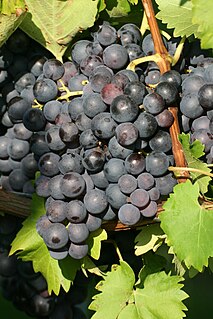
The Piave is a river in northern Italy. It begins in the Alps and flows southeast for 220 kilometres (140 mi) into the Adriatic Sea near the city of Venice. One of its tributaries is the Boite.

Trollinger, Schiava, or Vernatsch, is a red German/Italian wine grape variety that was likely first originally cultivated in the wine regions of South Tyrol and Trentino, but today is almost exclusively cultivated on steep, sunny locations in the Württemberg wine region of Baden-Württemberg. It is primarily known under the synonyms Trollinger in Germany, Vernatsch in South Tyrol and Schiava in other Italian regions. As a table grape the variety is sometimes known as Black Hamburg, which is commonly confused with the similar synonym for Black Muscat—a variety that is actually a cross of Trollinger and Muscat of Alexandria.

Italian wine is produced in every region of Italy, home to some of the oldest wine-producing regions in the world. Italy is the world's largest producer of wine, with an area of 702,000 hectares under vineyard cultivation, and contributing a 2013–2017 annual average of 48.3 million hl of wine. In 2018 Italy accounted for 19 percent of global production, ahead of France and Spain. Italian wine is both exported around the world and popular domestically among Italians, who consume an average of 42 litres per capita, ranking fifth in world wine consumption.
Picolit is a white Italian wine grape grown in the Friuli Venezia Giulia region of northeast Italy. The grape is allowed in the Denominazione di origine controllata e garantita (DOCG) wines of Colli Orientali del Friuli. The grape is most commonly associated with sweet dessert wines often made in the passito style. Historically planted in poor and infertile vineyards, the grape gets its name from the very small stalk, which in friulian language is called pecolèt or pecolùt. The grape had a worldwide reputation in the 18th century when it was featured in royal courts from Great Britain to the Russian Empire. While experiencing cult wine popularity in the 1960s & 1970s, Picolit's extremely small yields have made it economically difficult to grow and has limited the number of plantings.

Soave is a dry white Italian wine from the Veneto region in northeast Italy, principally around the city of Verona. Within the Soave region are both a Denominazione di Origine Controllata (DOC) zone and since 2001 a Denominazione di Origine Controllata e Garantita (DOCG) designation known as Soave Superiore, with both zones being further sub-divided into a general and Classico designation for the wines produced in the heartland of the Soave region around the sloping vineyards of Verona.

Breganze is a town in the province of Vicenza, Veneto, Italy. It is northeast of Via Romea. During World War II, the Germans were on one side of the river and the Allies were on the other, and a firefight occurred across the river.

Merlara is a comune (municipality) in the Province of Padua in the Italian region of Veneto, located about 80 kilometres (50 mi) southwest of Venice and about 45 kilometres (28 mi) southwest of Padua. As of 31 December 2004, it had a population of 2,980 and an area of 21.4 square kilometres (8.3 sq mi).
Sauvignon vert is a white wine grape of the species Vitis vinifera prevalent in the Italian region of Friuli. It is widely planted in Chile where it was historically mistaken for Sauvignon blanc. The grape is distinct from the California planting of Muscadelle which is also called Sauvignon vert.
Ramandolo is a sweet white Italian wine from the village of the same name which is situated in the hills near Nimis in the Friuli-Venezia Giulia wine region of northeast Italy. It is made from a local variety of the Verduzzo grape. Since 2001, Ramandolo has been produced as a DOCG wine. Prior to this it was a subzone of the Colli Orientali del Friuli DOC.

Friuli-Venezia Giulia wine is wine made in the northeastern Italian region of Friuli-Venezia Giulia. Once part of the Venetian Republic and with sections under the influence of the Austro-Hungarian Empire for some time, the wines of the region have noticeable Slavic and Germanic influences. There are 11 Denominazione di origine controllata (DOC) and 3 Denominazione di Origine Controllata e Garantita (DOCG) in the Friuli-Venezia Giulia area. The region has 3 Indicazione Geografica Tipica (IGT) designations Alto Livenza, delle Venezie and Venezia Giulia. Nearly 62% of the wine produced in the region falls under a DOC designation. The area is known predominantly for its white wines which are considered some of the best examples of Italian wine in that style. Along with the Veneto and Trentino-Alto Adige/Südtirol, the Friuli-Venezia Giulia forms the Tre Venezie wine region which ranks with Tuscany and Piedmont as Italy's world class wine regions.

Moscato Giallo or Yellow Muscat is a white Italian wine grape variety that is a member of the Muscat family of grapes. Known for its large deep cluster of loose, deep-yellow berries and golden colored wine, Moscato Giallo is grown mostly in northern Italy where it is most often used to produce passito style dessert wines. The grape is also planted in Croatia where it is known as Muškat žuti.
The Colli Orientali del Friuli is a Denominazione di origine controllata (DOC) located in the Italian wine region of Friuli-Venezia Giulia. The region is located in the province of Udine and is sub-divided into three main sections; Ramandolo in the north, Cialla and Corno di Rosazzo. The climate and soil is very similar to the neighboring DOC of Collio Goriziano and the two region share many winemaking similarities as well. The main distinction between the Colli Orientali del Friuli and Collio Goriziano lie in the increased red and dessert wine production of the Colli Orientali del Friuli. The region also includes within its boundaries the three Denominazione di Origine Controllata e Garantita (DOCG) of the Friuli-Venezia Giulia Ramandolo and the two passito wine DOCGs of Colli Orientali del Friuli Picolit and Colli Orientali del Friuli Picolit-Cialla.

Vespaiola is a white Italian wine grape variety planted primarily in the Veneto region of northeastern Italy, where it is often dried to produce passito style dessert wines. Along with Friulano, Vespaiola is an important component in the Denominazione di origine controllata (DOC) white wine of Breganze produced in the province of Vicenza.
Perricone is a red Italian wine grape variety that is grown in Sicily. In the late 20th century there was around 1000 hectares/2,500 acres of the grape planted throughout the island. According to wine expert Oz Clarke in Sicily Perricone is used to make full bodied, deeply colored, highly alcoholic wines.
Abrusco is a red Italian wine grape variety grown primarily in the Tuscany region where it is a minor blending component permitted in the wines of Chianti. The grape has long history in the region and was mentioned in 1600, under its synonyms Abrostino and Colore, in the posthumously published work by Italian agronomist Giovan Vettorio Soderini Trattato della coltivazione delle viti, e del frutto che se ne può cavare. There Soderini notes that the grape was often used to add deeper, more red color to Tuscan wines.

Pecorino is a white Italian wine grape variety that grows in the Marche, Abruzzo, Tuscany, Umbria and Lazio regions of Italy. Ampelographers believe that the grape is likely native to Marche, where the soil destined for this cultivation increases every year. This grape variety is used to produce the DOCG wines, like the Offida Pecorino DOCG, and the DOC wines, like the Falerio dei Colli Ascolani, the Colli Maceratesi and the Falerio dei Colli Ascolani.
Verduzzo Trevigiano is a white Venetian grape variety that is grown in the Eastern Veneto wine area. In the past the name Verduz referred to a wide range of grape varieties in the Venetian area. By the descriptions found, they were often morphologically very different, but shared the character of late ripening. However we can very frequently find the name Verduzzo in the ampelographic list of the 19th century, there is not any sign of this Verduzzo until the beginning of the 20th century. At that time just two varieties, with the same name Verduzzo, were still coltivated in the Veneto and Friuli area, they were what we today call Verduzzo Friulano and Verduzzo Trevigiano. The two varieties are clearly different, as demonstrated even with DNA profiling analyses in 2010 and 2011. However at the beginning of the 20th century, the two Verduzzo were called with the same name and often were present in the same vineyard and made wine together. Cosmo proposed to call the two varieties with different names: Verduzzo friulano for the varieties typical of Ramandolo production that was the only one present in that area of Friuli, and Verduzzo Trevigiano for the other one, that was present in the oriental zone of Veneto, where even Verduzzo friulano was spread, but which has a sure origin in the Treviso province how showed by the papers of Lepido Rocco.

Nosiola is a white Italian wine grape variety that is grown in the Trentino region north of Lake Garda in the Valle dei Laghi. Here it is used in varietal Denominazione di origine controllata (DOC) wines and as a blending component in wines such as Sorni Bianco from Trento. It is also used to produce a dessert wine in the Vin Santo style from grapes that have been allowed to dry out prior to fermentation.
Negrara is a red Italian wine grape variety grown in north east Italy including the Veneto region where it is a permitted variety in the Denominazione di origine controllata (DOC) wine Amarone. While the grape was once more widely planted in the region its numbers have been steadily declining for most of the late 20th and early 21st century.
Collio Goriziano is an Italian wine and winemaking region in northeast Italian region of Friuli-Venezia Giulia, located in the northernmost part of the Province of Gorizia, in the Italian part of the Gorizia Hills, which extend to neighboring Slovenia. It has been recognized with the official the status of DOC. Colli Goriziano predominately produces white wines with Friulano, Ribolla Gialla, Malvasia Istriana, Chardonnay, Pinot bianco, Pinot grigio, and Sauvignon blanc being the leading varietals. Red wine is also produced under the Collio Rosso designation and is usually a blend of Merlot, Cabernet franc, and Cabernet Sauvignon.














